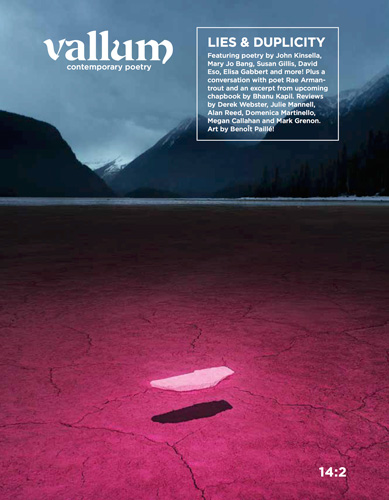Vallum – 2017
This literary magazine is excellent for anyone who enjoys thought provoking poems. In this issue of Vallum, the focus is on “Lies and Duplicity,” and features a number of great poets, a collection of visual art, a conversation with poet Rae Armantrout, and book reviews by various authors.
This literary magazine is excellent for anyone who enjoys thought provoking poems. In this issue of Vallum, the focus is on “Lies and Duplicity,” and features a number of great poets, a collection of visual art, a conversation with poet Rae Armantrout, and book reviews by various authors.
When rifling through this issue, the first immediate eye catcher for me was the artwork completed by Benoît Paillé. The images are provocative, thoughtful, and very interesting, each one telling their own story, just like the poems found around them.
Some of these visual art pieces also work nicely with the poems found before or after, such as one “Untitled” piece found right before Alexander Tkachuk’s “Essay on Modernity.” The image shows a man seemingly emerging from a washing machine at a coin laundry business, while the poem focuses on how our modern era has left us in “the age of motorized relaxation and digital dogmatism.” As the poem suggests, we struggle to find meaning in “the age of club drugs and pink sludge” where we are in danger of “flying too close to the sun” without seeing that it is a sun, and eventually being swallowed by that same sun “in a fit of indifference.” With our modern age, it is too easy to lose meaning in anything and to get lost in the lack of real definition and purpose. The pairing of this piece with the art brings that to light very clearly.
As we struggle to find meaning in life, Mary Lee Bragg’s poem “Ranked in Order” highlights the fact that we are all telling some sort of lie to the different people we encounter every day. These lies have different purposes, but we use them to help justify what we do, say, think, or feel. As her poem states:
Most important are the ones we tell ourselves.
Everyone does it
It’s not that big a deal.
No one will know.
According to this poem, we tell ourselves, our loved ones, our friends, our bosses, and even strangers on the street some kind of “lie” every day. We cover ourselves in these lies so that we can keep going, “Always looking forward, never looking back.” What a powerful concept here.
Antony Di Nardo’s poem “Food Court” also touches on this theme of lies by pointing out that we surround ourselves with “fake” constructs in order to give the appearance of something real. In this case, he pictures a food court, “Where the benches are eco-friendly recycled imitation polymers, neo-outdoor revivalist by decree” and “The trees in harmony harmonize with artificial casts of lighting filtered through scrubbed acrylic planes of faux transparence.” I think we have all been in these places at some point—a space inside a building that pretends to be outside, trying to fake the beauty of nature. Even though we know it is fake, does it still give us comfort? I would have to assume some study somewhere indicated that people found these displays soothing, or why else would they be used so frequently? The very idea piques my curiosity and makes me wonder, always a sign of a good poem.
One of the most powerful poems I found in this issue came from Crystal Hurdle, titled “Veterinarian Dr. Bondo.” Here, the veterinarian “aims for tousled boyish charm” even as he sells every possible option to his patients, from special toothbrushes to special dietary food, all the while charging every possible fee. In the end, the final charge goes to euthanasia and an attempt to assure the pets’ owners that “Muffin will barely feel a thing.” This poem affected me personally as someone who cares so much for her own pets and who has had to deal with both good and bad veterinarians—the ones who truly care and don’t want to overcharge versus the ones who don’t care as much and will charge for anything. It reminds me of how fragile the lives of our pets are and how deeply we care about them, paying the little bit extra for the full blood panel in the hopes that our little “honeybabies” will make it another 6 months. There is such a dark, bitter truth to this poem that I found to be very potent.
In addition to the poems and visual artwork, there were also excerpts from the Vallum Chapbook Series No 22, entre-Ban by Bhanu Kapil, and a conversation with Pulitzer-Winning Poet Rae Armantrout, who states that “Poems hold conflicting positions and impulses in precarious balance for a moment. In poems, the words speak to one another. Poems don’t give answers, they raise questions.” I love this statement for its honest truth. Poems don’t give answers to anyone—they are words on a page that you read and interpret, raising questions you have to answer for yourself.
Nowhere is this truer than in the “Lies and Duplicity” issue of Vallum. These poems raise questions for me—so many questions! They make me question the reality of our modern era, the point of our existence, and even the purpose behind the faux nature scenes in food courts worldwide. I strongly suggest reading this issue and seeing just what questions it raises for you.
[www.vallummag.com]





